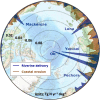Around one third of current Arctic Ocean primary production sustained by rivers and coastal erosion
- PMID: 33420093
- PMCID: PMC7794587
- DOI: 10.1038/s41467-020-20470-z
Around one third of current Arctic Ocean primary production sustained by rivers and coastal erosion
Abstract
Net primary production (NPP) is the foundation of the oceans' ecosystems and the fisheries they support. In the Arctic Ocean, NPP is controlled by a complex interplay of light and nutrients supplied by upwelling as well as lateral inflows from adjacent oceans and land. But so far, the role of the input from land by rivers and coastal erosion has not been given much attention. Here, by upscaling observations from the six largest rivers and using measured coastal erosion rates, we construct a pan-Arctic, spatio-temporally resolved estimate of the land input of carbon and nutrients to the Arctic Ocean. Using an ocean-biogeochemical model, we estimate that this input fuels 28-51% of the current annual Arctic Ocean NPP. This strong enhancement of NPP is a consequence of efficient recycling of the land-derived nutrients on the vast Arctic shelves. Our results thus suggest that nutrient input from the land is a key process that will affect the future evolution of Arctic Ocean NPP.
Conflict of interest statement
The authors declare no competing interests.
Figures




References
-
- Kattner G, Budéus G. Nutrient status of the northeast water polynya. J. Mar. syst. 1997;10:185–197. doi: 10.1016/S0924-7963(96)00070-X. - DOI
-
- Simpson, K. G., Tremblay, J ‐ É., Gratton, Y. & Price, N. M. An annual study of inorganic and organic nitrogen and phosphorus and silicic acid in the southeastern Beaufort Sea, J. Geophys. Res. 113, C07016 (2008).
-
- Tremblay JE, et al. Global and regional drivers of nutrient supply, primary production and CO2 drawdown in the changing Arctic Ocean. Prog. Oceanogr. 2015;139:171–196. doi: 10.1016/j.pocean.2015.08.009. - DOI
-
- Meredith, M. & Sommerkorn, M. IPCC Special Report on the Ocean and Cryosphere in a Changing Climate (SROCC), Chapter 3 (IPCC, Geneva, Switzerland, 2019).
Publication types
LinkOut - more resources
Full Text Sources
Other Literature Sources

